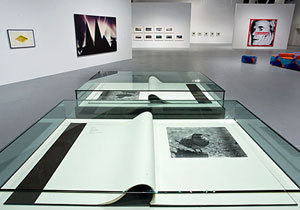Index
dal 23/8/2009 al 14/12/2009
Segnalato da
Michael Asher
John Baldessari
Douglas Huebler
David Lamelas
William Leavitt
Allen Ruppersberg
Edward Ruscha
Allan Sekula
Wallace Berman
Bruce Conner
Jack Goldstein
Barbara Kruger
Mitchell Syrop
James Welling
Christopher Williams
Nayland Blake
Meg Cranston
Richard Jackson
Mike Kelley
Martin Kersels
Stephen Prina
Cindy Bernard
T. Kelly Mason
Dave Muller
Richard Hawkins
Sharon Lockhart
Sarah Seager
Diana Thater
Lincoln Tobier
Jim Isermann
Jorge Pardo
Pae White
23/8/2009
Index
MOCA at the Geffen Contemporary, Los Angeles
Conceptualism in California from the Permanent Collection

A survey of conceptual and post-studio practices in California, Index: Conceptualism in California from
the Permanent Collection draws on MOCA’s substantial holdings of work by California-based artists who
have contributed to the international lexicon of conceptualism. Since its inception, the museum has
played a significant role in both defining and expanding the parameters of conceptual art, presenting
comprehensive benchmark surveys including A Forest of Signs: Art in the Crisis of Representation (1989)
and 1965–1975: Reconsidering the Object of Art (1995).
Conceptual art developed during the late 1960s in response to the preceding pop and minimalist
movements, as well as to tumultuous events including the Korean and Vietnam wars and civil rights
and labor movements. Intellectually rigorous and often humorous, conceptual practices emphasize
the primacy of ideas over objects, often employing language, repetition, and documentation and
incorporating historical and cultural references. In addition, many works present critical responses to
the institutions of art themselves (an approach literalized in Chris Burden’s Exposing the Foundation
of the Museum [1986/2008]). At the core of Index is an emphasis on the crucial period spanning the
late 1960s to the mid-‘70s, when Michael Asher, John Baldessari, Douglas Huebler, David Lamelas,
William Leavitt, Allen Ruppersberg, Edward Ruscha, and Allan Sekula, as well as proto-conceptualists
like Wallace Berman and Bruce Conner, were creating work that would come to epitomize the tenets
and strategies of conceptual art.
Recognizing the important legacy and long-ranging influence of the 1960s and ‘70s, Index also
presents post-conceptual explorations by the next generation, including Jack Goldstein, Barbara
Kruger, Mitchell Syrop, James Welling, and Christopher Williams. During the late 1970s, California
Institute of the Arts in Valencia; University of California, Los Angeles; and San Francisco Art Institute
were among the many influential schools in California where artist-teachers like Asher and Baldessari
advocated a pedagogy rooted in intensive individual studio practice balanced with critical discussion.
Informed by pop, minimal, conceptual, and feminist art, the work of second-generation conceptualists
coming out of these schools is characterized by its ironic distance and concern with gender roles,
sexuality, the construction of identity, and the wide-ranging psychological impact of media and
corporate cultures. Many of these artists joined a variety of media into single works: Nayland Blake,
Meg Cranston, Richard Jackson, Mike Kelley, Martin Kersels, and Stephen Prina combined sculpture,
performance, painting, drawing, and photography to startling effect, often using found objects and
mundane imagery to rethink autobiographical narratives through conceptual frameworks.
As is well documented in the writing about California art of the 1990s, the physical and cultural
landscape of the region fosters diversity in art practices, as does the multigenerational makeup of the
artist community. Responding to earlier conceptual modes, artists including Cindy Bernard, T. Kelly
Mason, and Dave Muller cultivated multifaceted practices resulting in works in media that are melded
or invented, with an emphasis on social interaction as an aesthetic activity. Research-based content and
highly specific installation details inform the practices of artists like Richard Hawkins, Sharon Lockhart,
Sarah Seager, Diana Thater, and Lincoln Tobier, while works by Jim Isermann, Jorge Pardo, and Pae
White quote directly from the decorative arts and innovative 20th-century design to explore a cultural
understanding of furniture, architecture, and sculpture.
As the vocabularies of contemporary art are shaped by California’s rich artist community, the roots and
influence of conceptual art are constantly and simultaneously present and evolving. With generations in
dialogue within art schools and in studios throughout the region, California artists continue to innovate
from the solid foundation of conceptualism.
Index: Conceptualism in California from the Permanent Collection is made possible in part by The Executive Forum
Partners: Bank of America; East West Bank; Farmers Insurance Group; Park Fifth; Plaza Commons, Inc.; Resnick Family
Foundation, Inc.; and UBS.
Image: Installation view of Index: Conceptualism in California from the Permanent Collection at The Geffen Contemporary at MOCA, 2008, photo by Brian Forrest
Media contact:
Lyb Winter tel 213 6335390 lwinter@moca.org
The Geffen Contemporary at MOCA
152 North Central Avenue, Los Angeles, California, 90013
Hours: Mon: 11-5, Thurs 11-8, Fri 11-5, Sat-Sun 11-6
Closed: Tuesday, Wednesday
General Admission: $10
Students with I.D.: $5
Seniors (65+): $5
Children under 12: Free
MOCA at the Geffen Contemporary
152 North Central Avenue - Los Angeles



